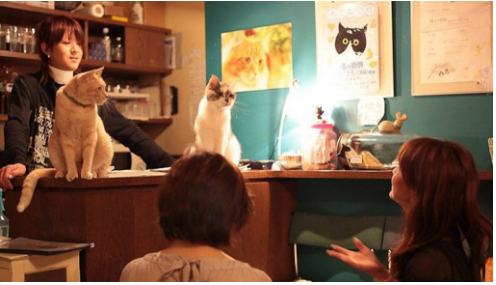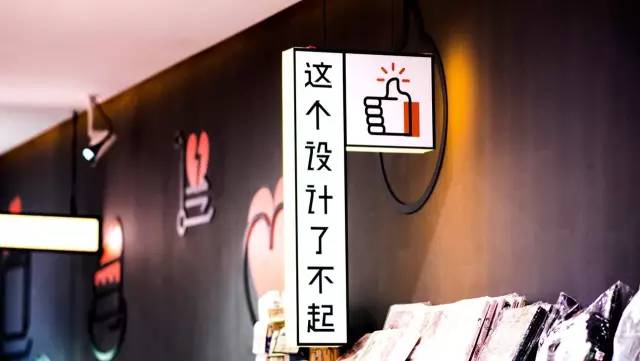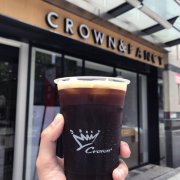The theme of "Cat Powder" Coffee Coffee will become an upstart
Recently, there is a very popular economic term in Japan-"cat economics". Due to the increasing number of singles in Japan, the popularity of cat ownership is unprecedented, and economists have found that in any field, as long as cats appear, they can attract public attention and make a profit.
It is not hypothetical that cats have become a business symbol. According to a study by scholars at Kansai University in Japan, cats have contributed more than 2.3 trillion yen to Japan's GDP, far more than the idol group AKB48.
And this momentum seems to be beginning to spread in China. Cat-themed cafes, which were new two or three years ago, have now reached dozens or even hundreds in first-tier cities such as Beijing and Shanghai, and cat cafes in second-tier cities have begun to attract more and more competitors.
Compared with other themed coffee shops, as a warm harbor for urbanites to heal their hearts, most cat coffee shops tend to be more popular, but the price per customer is not low. it stands out among a large number of coffee peers who are difficult to guarantee, let alone continue to make a profit.
Cat coffee faces the target customer group of "cat powder", which is the urban white-collar group with spending power and desire. This niche market segment has considerable prospects, and now it has become more and more interesting.
The guest group is mainly the young people.
In addition to women who are crazy about cats, cat cafes can also attract all social classes, but they are mainly urban white-collar workers and students.
For many white-collar customers who love cat cafes, cats have a good soothing effect on the stress accumulated after a long day at work. It doesn't matter what you eat or drink in the cat cafe. The most important thing is the warm and healing atmosphere here. Many guests come in tired and leave with a smile on their faces.
On weekends and holidays, the store is generally more lively because of the students' holidays. Cat cafes have a wide variety of cats, and some shops also keep expensive cats. For customers who like cats but cannot afford them, or whose families do not want to keep them or cannot afford them, cat coffee can meet all their needs for pet cats.
From the first into the domestic business coffee, to Starbucks as the representative of fast-vanishing coffee, and then to the above island coffee as the representative of leisure coffee, a variety of personality theme coffee, coffee in the four ages, theme coffee can form the greatest differentiation.
Cat coffee is a niche market in the whole coffee ecosystem. For the fan community of "cat fans", there are both "leisure style" and distinctive themes, coupled with "cat culture", attracting tourists with pet themes and creating a beautiful offline experience for "cat fans" with environment and services. this model has been verified by the market.
The cat coffee craze has spread all over the world, but behind the cat economy is the city curing the economy.
According to the thinking of playing with chopsticks, the first cat coffee shop named Cafe & Cats was born in Taipei in 1998, while the first cat coffee in Japan, Cat time, was opened in Osaka in 2004, which sparked off the topic as soon as it opened, attracting many "shovel shit officials" to come to spend.
Today, Cat Cafe can be found all over Asia and Europe, and by 2014, the United States will have its first cat cafe, CatTownCafe.

Since the opening of the Cat City Cafe, cat cafes have sprung up in other cities across the United States, including New York, Denver, San Diego and Portland, Oregon.
Today, the leader in the development of cat coffee is still in Japan. At first, cat coffee shops are relatively small, but recently there have been many high-end decorated coffee shops in Shinjuku and Harajuku, with interior decoration close to that of high-end hotels.
In Japan, in addition to the common cat coffee, there are many types of animal cafes. Goats, owls, rabbits, dogs. There are as many as six or seven owl cafes in Kansai Osaka alone.
The owner of Cafe, a goat cafe in downtown Tokyo, began keeping two goats in captivity in 2010. Xiao Hei and Xiao Bai make bleating sounds to passers-by from time to time, attracting not only girls who love animals, but also male office workers.
At the USAYU Rabbit Cafe in Osaka, the floor is covered with soft cushions, and guests can sit on the ground with rabbits in their arms, while the protagonist of Caf é, a bird with several branches in Tokyo, features 22 colorful parrots. There is a glass room dedicated to intimate contact between customers and parrots, with parrots as the theme for all desserts, cups and decorative illustrations.
In China, most animal-themed cafes are still dominated by cats and dogs, but the number is on the rise. this kind of healing cafe is meeting the daily intimacy needs of urban people for cute pets. Going to the cat coffee to "pet the cat" and enjoying an afternoon in the store has become the most lively mode of urban cure economy.
The profit weapon of the traditional coffee shop
Under the background of the weak format of traditional cafes, cat coffee, as a cross-border between cafes and pet shops, has successfully attracted a large number of consumers to spend, and in order to make them spend repeatedly, cat coffee generally adopts the membership system.

Practitioners who opened cat coffee shops earlier have accumulated a certain number of members, and now members are the main profit contributors, while newly opened stores choose stores in shopping malls with high passenger traffic, and they can also accumulate members in a few months.
In terms of price, the price of each item sold in cat cafes is often higher than the market price. The price of a cup of brewed coffee is about 45 yuan, which is nearly 30% higher than the price of 34 yuan for similar items in Starbucks. Some high-frequency consumers of coffee will not accept it. For cat-loving consumers, this part can be seen as a ticket to play with cats.
Part of the reason for the high price is that cats, especially expensive cat breeds, need to pay high expenses. Cat food, snacks, regular medical check-ups, etc., a cat's monthly expenses are often more than 1,000 yuan; the other part is to consider the overturning rate. It is not uncommon for guests to order a cup of coffee to play in cat coffee for half a day.
But at present, many cat cafes have added a wider variety of light snacks and desserts to increase the unit price of guests.
In some second-tier cities, from the original scarcity to now "blooming everywhere", competition has intensified and business has become less easy to do. If there are no obvious characteristics in cat breeds, food tastes and environmental services, many cat coffees can only make ends meet.
Chopsticks play mind noticed that the acceptance of cat-themed cafes is getting higher and higher, consumers are getting wider and wider, and cat coffee has gradually stepped out of the niche market, and cat coffee has been at the critical point of outbreak period and industry reshuffle period. it has its own characteristics, pays more attention to the user experience of consumers, and can provide customized services and the mode of operation of surrounding goods in order to meet the diversified needs of customers and occupy a larger market share.
Cat Cafe is controversial, and hygiene and moral problems are difficult to solve.
The Cat Cafe has faced all kinds of controversy since its birth. First of all, there is the problem of hygiene. Some people find the floating cat hair and poorly handled feces disgusting.
Many cats are opened in alleys and even community residential buildings, the area is relatively small but there are more cats, the animal smell is difficult to eliminate, and the cat's hair will fall on the table and even on the food. Cats can also get sick, especially skin diseases can be transmitted from cat to cat. If shopkeepers do not take timely treatment and epidemic prevention measures, there is also a risk of transmission to customers.

In Japan, where cat coffee is more mature, cat coffee has strict rules for customers who come to the store. They usually need to wash their hands and change their shoes before entering, and guests are forbidden to bring their own food to the cat. Some even require cold customers not to enter the store.
In China, these requirements are not available in all stores, even if there are, it is not easy to implement, it is difficult to be completely clean, and for cafes that need to provide food for their guests, food safety has become the biggest hidden danger for cat cafes.
Another controversy comes from animal conservationists. In their view, cats like to be quiet, and being touched by strangers in the public environment of noisy cafes can cause a lot of psychological pressure. Cats have become human toys and profit-making tools, and lions in circuses and dolphins in aquariums are under the unnatural pressure of picking up customers at work.
In some poorly managed cat cafes, poor cats are held back and forth by guests, sleeping cats are awakened and there is no time to rest, all of which expose cat cafes to criticism and opposition from cat lovers.
Because it is new, regulators can not impose restrictions, but in the long run, with more and more entrants, operators who can not properly deal with coffee shop hygiene problems and cat health problems, will eventually be eliminated by the market.
Conclusion
Against the backdrop of increased disposable income and increased demand for leisure time and leisure, there is also a greater interest in cats, dogs and other pets, which makes the market for animal-related goods and services full of vitality.
As for the highly competitive leisure coffee industry, cafes with cats as the theme have created a fresh marketing theme, which makes cafes more advantageous in the face of market promotion and publicity, and finds the direction of market segmentation at the same time. Operating cafes based on crowd positioning can also accurately win customers.
However, compared with the coffee market as a whole, pet-themed cafes are still minority and easily saturated.
Chopstick thinking believes that if similar cafes continue to emerge, how to adjust their business strategy is the key to whether they can avoid being eliminated-the emergence of high-end cat cafes, cafes with special breeds of cats, and so on, are all manifestations of this trend.
Important Notice :
前街咖啡 FrontStreet Coffee has moved to new addredd:
FrontStreet Coffee Address: 315,Donghua East Road,GuangZhou
Tel:020 38364473
- Prev

Aitao Coffee Brand Design case sharing
Today, I will tell you in detail about the creativity of Amoy Coffee and the Amoy culture passed on through the brand. Through a series of communication, the design team decided to use Taobao dolls for in-depth design, and through simple geometric lines, the coffee culture and brand image better infiltrate each other, users and products can also better interact. The brand LOGO mainly takes Taobu dolls as the main image.
- Next

Stop drinking beer. Coffee tastes best this summer!
Exchange of professional baristas Please pay attention to the coffee workshop (Wechat official account cafe_style) the summer when the somatosensory temperature will soar above 40 degrees, the most important enjoyment you can't miss is hiding under a big sunshade, looking at the sea breeze, holding ice cool, smooth taste, coffee with dense foam, and so on! Coffee!? You read it right, it's the magician of the coffee world, Gold Coffee.
Related
- What ratio of water temperature and ground does the smart cup method use to press coffee? The difference between brewed coffee and filtered coffee?
- What is the standard process for the purpose of coffee cup testing? What is the difference between hand-brewed coffee and cup testing?
- How to use hand-brewed coffee paragon small golden balls? How does cold coffee lock in the aroma of coffee?
- Is American coffee black? What is the difference between American coffee and drip coffee?
- Unexpected! Well-known tea beverage brand Lele Tea will withdraw from the Zhengzhou market!
- Starbucks enters the fashion and beauty industry?! Netizen: Give me an ice American eye cream
- Why can American refills for free? The difference between Americano and American drip pot coffee
- Being chased out of the rain in front of Starbucks?! Store: Sheltering from rain under umbrellas poses a safety hazard
- The white moonlight has changed?! Lucky launches "Big Winter Pear American"
- Hand-brewed coffee three-stage method, high-sweet and universal brewing method to share! What does the high sweet water level of hand-brewed coffee mean?

